
Flies are insects of the order Diptera, the name being derived from the Greek δι- di- "two", and πτερόν pteron "wing". Insects of this order use only a single pair of wings to fly, the hindwings having evolved into advanced mechanosensory organs known as halteres, which act as high-speed sensors of rotational movement and allow dipterans to perform advanced aerobatics. Diptera is a large order containing an estimated 1,000,000 species including horse-flies, crane flies, hoverflies and others, although only about 125,000 species have been described.

Crane fly is a common name referring to any member of the insect family Tipulidae, of the order Diptera, true flies in the superfamily Tipuloidea. Cylindrotominae, Limoniinae, and Pediciinae have been ranked as subfamilies of Tipulidae by most authors, though occasionally elevated to family rank. In the most recent classifications, only Pediciidae is now ranked as a separate family, due to considerations of paraphyly. In colloquial speech, crane flies are sometimes known as "mosquito hawks" or "daddy longlegs",. The larvae of crane flies are known commonly as leatherjackets.

The apple maggot, also known as the railroad worm, is a species of fruit fly, and a pest of several types of fruits, especially apples. This species evolved about 150 years ago through a sympatric shift from the native host hawthorn to the domesticated apple species Malus domestica in the northeastern United States. This fly is believed to have been accidentally spread to the western United States from the endemic eastern United States region through contaminated apples at multiple points throughout the 20th century. The apple maggot uses Batesian mimicry as a method of defense, with coloration resembling that of the forelegs and pedipalps of a jumping spider.

Mecoptera is an order of insects in the superorder Endopterygota with about six hundred species in nine families worldwide. Mecopterans are sometimes called scorpionflies after their largest family, Panorpidae, in which the males have enlarged genitals raised over the body that look similar to the stingers of scorpions, and long beaklike rostra. The Bittacidae, or hangingflies, are another prominent family and are known for their elaborate mating rituals, in which females choose mates based on the quality of gift prey offered to them by the males. A smaller group is the snow scorpionflies, family Boreidae, adults of which are sometimes seen walking on snowfields. In contrast, the majority of species in the order inhabit moist environments in tropical locations.
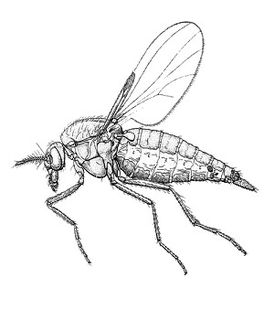
Leptoconops torrens is a species of small biting flies in the no-see-um family Ceratopogonidae. They were first mentioned in writing by Charles Henry Tyler Townsend in 1893. The name Leptoconops carteri is a junior synonym of L. torrens. They are prevalent in the southwestern and southeastern areas of the United States. In early stages of life, L. torrens flies dwell in soil, then emerge to feed and breed as fully developed adults.

The Nematocera are a suborder of elongated flies with thin, segmented antennae and mostly aquatic larvae. Major families in the suborder include the mosquitoes, crane flies, gnats, black flies, and a group of families described as midges.

The Limoniinae are a paraphyletic assemblage of genera within the crane flies, Tipulidae, although they can usually be distinguished by the way the wings are held at rest. Limoniines usually hold/fold the wings along the back of the body, whereas other tipulids usually hold them out at right angles. Snow flies such as Chionea scita have no wings at all. Limoniines are also usually smaller than other tipulids, with some exceptions. Limoniinae are a very large assemblage with nearly 10,500 described species in 133 genera, and were historically treated as a subfamily, but their classification is in flux; numerous authors recently treated the group at the rank of family, but subsequent phylogenetic analyses revealed that the remaining groups of tipulids render the group paraphyletic. These flies are found in damp places throughout the world, and many species form dense swarms in suitable habitats.
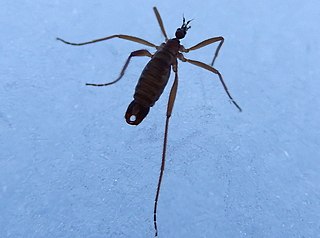
Chionea is a genus of wingless limoniid crane flies. It consists of two subgenera, the holarctic Chionea and palaearctic Sphaeconophilus. About 40 species are currently recognized in the northern hemisphere, but there are probably several undescribed species. They are commonly called snow flies.

Phormia regina, the black blow fly, belongs to the blow fly family Calliphoridae and was first described by Johann Wilhelm Meigen.

Scathophaga stercoraria, commonly known as the yellow dung fly or the golden dung fly, is one of the most familiar and abundant flies in many parts of the Northern Hemisphere. As its common name suggests, it is often found on the feces of large mammals, such as horses, cattle, sheep, deer, and wild boar, where it goes to breed. The distribution of S. stercoraria is likely influenced by human agriculture, especially in northern Europe and North America. The Scathophaga are integral in the animal kingdom due to their role in the natural decomposition of dung in fields. They are also very important in the scientific world due to their short life cycles and susceptibility to experimental manipulations; thus, they have contributed significant knowledge about animal behavior.
Rhagoletis juglandis, also known as the walnut husk fly, is a species of tephritid or fruit fly in the family Tephritidae. It is closely related to the walnut husk maggot Rhagoletis suavis. This species of fly belongs to the R. suavis group, which has a natural history consistent with allopatric speciation. The flies belonging to this group are morphologically distinguishable.
. Apterygota are a subclass of small, agile insects, distinguished from other insects by their lack of wings in the present and in their evolutionary history. They include Thysanura . Some species lacking wings are members of insect orders that generally do have wings. Some do not grow wings at all, having "lost" the possibility in the remote past. Some have reduced wings that are not useful for flying. Some develop wings but shed them after they are no longer useful. Other groups of insects may have castes with wings and castes without, such as ants. Ants have alate queens and males during the mating season and wingless workers, which allows for smaller workers and more populous colonies than comparable winged wasp species.
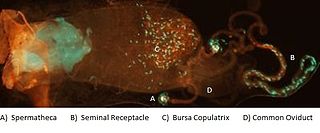
Female sperm storage is a biological process and often a type of sexual selection in which sperm cells transferred to a female during mating are temporarily retained within a specific part of the reproductive tract before the oocyte, or egg, is fertilized. The site of storage is variable among different animal taxa and ranges from structures that appear to function solely for sperm retention, such as insect spermatheca and bird sperm storage tubules, to more general regions of the reproductive tract enriched with receptors to which sperm associate before fertilization, such as the caudal portion of the cow oviduct containing sperm-associating annexins. Female sperm storage is an integral stage in the reproductive process for many animals with internal fertilization. It has several documented biological functions including:

The Mexican fruit fly also known as Anastrepha ludens and the Mexfly is a species of fly of the Anastrepha genus in the Tephritidae family. It is closely related to the Caribbean fruit fly Anastrepha suspensa, and the papaya fruit fly Anastrepha curvicauda.

Dryomyza anilis is a common fly from the family Dryomyzidae. The fly is found through various areas in the Northern hemisphere and has brown and orange coloration with distinctive large red eyes. The life span of the fly is not known, but laboratory-reared males can live 28–178 days. D. anilis has recently been placed back in the genus Dryomyza, of which it is the type species. Dryomyzidae were previously part of Sciomyzidae but are now considered a separate family with two subfamilies.
Most insects reproduce oviparously, i.e. by laying eggs. The eggs are produced by the female in a pair of ovaries. Sperm, produced by the male in one testis or more commonly two, is transmitted to the female during mating by means of external genitalia. The sperm is stored within the female in one or more spermathecae. At the time of fertilization, the eggs travel along oviducts to be fertilized by the sperm and are then expelled from the body ("laid"), in most cases via an ovipositor.
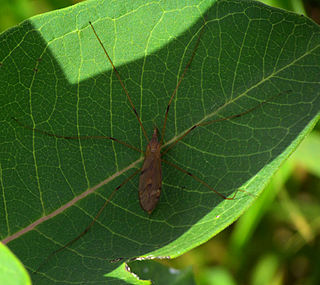
Eriopterini is a tribe of limoniid crane flies in the family Limoniidae. There are more than 20 genera and 3,800 described species in Eriopterini.
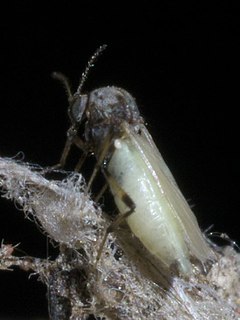
Bezzia nobilis is a species of biting midges in the family Ceratopogonidae. It is widely considered one of the most common Bezzia species; it is found in Eurasian regions, all over the United States, Central America, and even into South American countries like Brazil. B. nobilis seem to prefer aquatic environments; they are commonly observed in stagnant water pools in Eurasia regions and marshes in the southern United States. Adults of this species are easily distinguished by their black and yellow striped legs. Pupae are recognized by their brown bodies, abdominal spines, and respiratory horns. B. nobilis larvae are distinguished by brown heads and white bodies. Little information is known on their life cycle or mating habits. B. nobilis is a predatory species. While some research suggests they mainly feed on larvae of other insect species, experiments suggest they prefer immobile, easy prey such as dead adult flies, bacteria, and protozoa.
Telostylinus angusticollis is a fly in the family Neriidae of the insect order Diptera. They are typically found on the east coast of Australia near rotting vegetation. Aggregating on the rotting bark of trees such as Acacia longigolia and other trees in New South Wales and southern Queensland. T. angusticollis flies found in the wild have accelerated speeds of development and age of mortality when compared to those in captivity.

Coelopa pilipes is a common European species of kelp fly. It was described by A. H. Haliday in 1838. Their appearance differs greatly from that of other Coelopa flies.


















